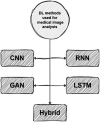Medical image analysis using deep learning algorithms
- PMID: 38026291
- PMCID: PMC10662291
- DOI: 10.3389/fpubh.2023.1273253
Medical image analysis using deep learning algorithms
Abstract
In the field of medical image analysis within deep learning (DL), the importance of employing advanced DL techniques cannot be overstated. DL has achieved impressive results in various areas, making it particularly noteworthy for medical image analysis in healthcare. The integration of DL with medical image analysis enables real-time analysis of vast and intricate datasets, yielding insights that significantly enhance healthcare outcomes and operational efficiency in the industry. This extensive review of existing literature conducts a thorough examination of the most recent deep learning (DL) approaches designed to address the difficulties faced in medical healthcare, particularly focusing on the use of deep learning algorithms in medical image analysis. Falling all the investigated papers into five different categories in terms of their techniques, we have assessed them according to some critical parameters. Through a systematic categorization of state-of-the-art DL techniques, such as Convolutional Neural Networks (CNNs), Recurrent Neural Networks (RNNs), Generative Adversarial Networks (GANs), Long Short-term Memory (LSTM) models, and hybrid models, this study explores their underlying principles, advantages, limitations, methodologies, simulation environments, and datasets. Based on our results, Python was the most frequent programming language used for implementing the proposed methods in the investigated papers. Notably, the majority of the scrutinized papers were published in 2021, underscoring the contemporaneous nature of the research. Moreover, this review accentuates the forefront advancements in DL techniques and their practical applications within the realm of medical image analysis, while simultaneously addressing the challenges that hinder the widespread implementation of DL in image analysis within the medical healthcare domains. These discerned insights serve as compelling impetuses for future studies aimed at the progressive advancement of image analysis in medical healthcare research. The evaluation metrics employed across the reviewed articles encompass a broad spectrum of features, encompassing accuracy, sensitivity, specificity, F-score, robustness, computational complexity, and generalizability.
Keywords: convolutional neural networks; deep learning; image analysis; machine learning; medical images.
Copyright © 2023 Li, Jiang, Zhang and Zhu.
Conflict of interest statement
The authors declare that the research was conducted in the absence of any commercial or financial relationships that could be construed as a potential conflict of interest.
Figures










References
-
- Zhang D, Wu G, Zhou L. Machine learning in medical imaging. Berlin: Springer; (2014).
-
- Amiri Z, Heidari A, Navimipour NJ, Unal M, Mousavi A. Adventures in data analysis: a systematic review of deep learning techniques for pattern recognition in cyber-physical-social systems. Multimed Tools Appl. (2023) 2023:1–65. doi: 10.1007/s11042-023-16382-x - DOI
-
- Sudheer Kumar E, Shoba Bindu C. Medical image analysis using deep learning: a systematic literature review In: Somani AK, Ramakrishna S, Chaudhary A, Choudhary C, Agarwal B, editors. Emerging Technologies in Computer Engineering: Microservices in big data analytics: Second international conference, ICETCE 2019. Jaipur, India: Springer; (2019). 81–97.
-
- Altaf F, Islam SM, Akhtar N, Janjua NK. Going deep in medical image analysis: concepts, methods, challenges, and future directions. IEEE Access. (2019) 7:99540–72. doi: 10.1109/ACCESS.2019.2929365 - DOI
Publication types
MeSH terms
LinkOut - more resources
Full Text Sources

